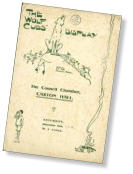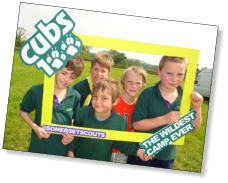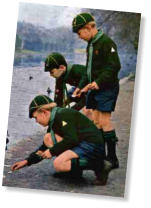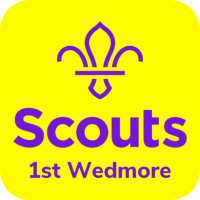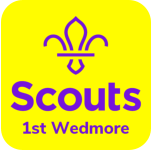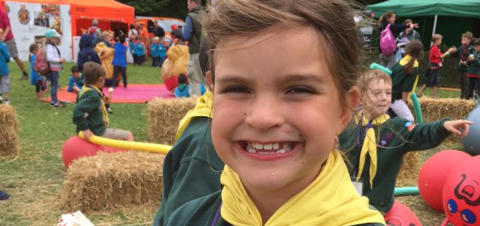
Joining
Being invested
Your uniform
Badges to get
About Beavers

Who are Cubs?
Cubs are young people aged 8 to 10½ who make friends, are curious about the world around them, have fun and adventures, learn new skills and try new things. Every week, they gather in groups called Cub Packs to take part in lots of exciting and challenging activities – achieving anything they set their minds to and having lots of fun along the way. They go on adventures, tell stories by torchlight, go on moonlit hikes, and make the most of what they have, wherever and whoever they are. They also learn new skills by doing, like giving someone first aid or becoming a master at their chosen hobby, but the most important ones are those that make them feel confident and happy, and having the courage to try new things and learning from them. Cubs work as a team to help other people by learning about global issues affecting their community, such as collecting donations for a food-bank or planting trees.Joining Cubs
You can go to the Cub's meeting once you are eight years old or over. After you've been to your first meeting, you'll soon find that you are ready to join the Pack and find out what Cub Scouting is all about. To become a Cub, you need to earn your Membership Award - for this need to find out about the Cub Pack by: • Getting to know the other members and leaders in your Six and Pack • Finding out about the ceremonies and traditions in your Pack. • Finding out about the activities that your Pack does. • Finding out the meanings of the badges you will receive. • Showing that you know about the family of Scouts, worldwide Scouting and the history of Scouting. • Become a Cub Scout by making the Promise when you are InvestedIf you are a Beaver Scouts, you can start the Cub
Membership Award about three weeks before you are
due to join the Pack as part of your Beaver Moving-on
Award. You can wear this on your Cub Scout uniform
and can transfer these Beaver Scout badges to your
new Cub Scout uniform:
• Joining In Badge (highest number) • Moving-On Award • Chief Scout’s Bronze Award • Any Staged Activity Badges that you have (highest stage gained). Download information about CubsGetting Invested
Your Investiture is a special day when you make your Cub Promise for the first time. Then, you become a member of Wedmore Cubs and receive the Membership Award, which means that you are part of Scouts' worldwide family. If you don't already have one, you will receive a lemon and red coloured scarf (sometimes called a 'necker') with the 'Isle of Wedmore' badge on it to show that you are part of Wedmore Group. Your parents and family usually come to hear you make your promise at the investiture ceremony, which is your formal welcome to the Pack. It is an important occasion for you as a new Cub and for the whole Pack.Cub Promise & Law
As far as possible, it would be best if you tried to learn your Promise off-by-heart, as you try your best to live by it. However, we understand that you may get nervous when speaking in front of the Cub Pack, so you will usually repeat your Promise after a leader during your investiture. The Cub Scout Promise is: ‘I promise that I will do my best, to do my duty to God and to the King to help other people and to keep the Cub Scout Law.’ If you are new to Scouting, you become a Member of the worldwide Scout Movement by making your Promise. There are alternative wordings of the Promise for members of faiths for whom the original wording is inappropriate. Every Cub Scout should also know the Cub Scout Law, which is: ‘Cub Scouts always do their best, think of others before themselves, and do a good turn every day.’ Download a Cub Promise sheetYour uniform
It would be best if you bought your uniform a few weeks after joining the Pack to ensure that you settle in and that Scouting is for you. The main parts of the Cub Scout uniform are • Group Scarf – Wedmore Scout Group, wear a lemon and red coloured scarf. Sometimes it is called a ‘necker’. It has the Wedmore Group badge on the back of it. The scarf is presented to you when you are invested in the Pack. Most Beaver Scouts like to wear their old scarf. • Woggle – this is a coloured plastic or leather ring, which holds your scarf in place. The colour shows which Six you belong to and will be given to you when you are invested. • Sweatshirt – A dark green sweatshirt that you can sew your Cub Scout badges on. • Trousers – These are dark blue with a scout logo on themChallenges & badges
You can see how you are getting on in the Cubs, as there are several Challenge Awards to try to gain. You will do most of the things that you need to complete during your regular weekly meetings. There are also Activity Badges to test your skills and help you with new interests. These can also help you complete some of your Challenge Awards and the Chief Scout's Award. Additionally, special staged badges cover a range of topics and skills you can tackle through your time in the Beavers Cubs and Scouts. You may need help from a grown-up person to understand what you need to do for some badges.Challenge Awards
You need to gain all of the Challenge Awards plus six activity or staged activity badges of your choice to get the Chief Scout's Silver Award. There are seven Challenge Awards to test your skill and determination. Clicking on the badges to the right will tell you what you need to do to meet the challenge. You can attempt a Challenge Award more than once; however, if you do, you will have to work harder at it the second time around. Click on any of the badges to go to the Scout Association website, which will tell you what you need to do to meet the challenge. You can download an App for your mobile phone or note pad that gives you details of all the awards and badges you can gain, as wells as the promise and law - go to download nowChief Scout's Silver Award
This badge is the highest award available in the Cubs and one that you should try to get. To gain it, you must have completed all of the Challenge Awards and have earned six activity or staged activity badges of your choice. If you have not entirely completed the requirements for this award when you move on to the Scout Troop, you can complete it in your first few weeks with the ScoutActivity Badges
They cover a huge range of skills, experiences and interests, and are designed to be achieved by you at home or through a hobby that you have, or you may want to try on something that is of particular interest to you. Click here to go to the Scout Association website where you will find a list of all of the Cub Activity Badges and details of what do to achieve them.Staged Badges
These badges have several stages, which get more difficult as they go on - they are to help you develop your special interests and help complete your Challenge and Chief Scout's Awards. They can be done in any order and cover a range of topics and skills; you can begin at whatever stage you find to be the hardest. However, the stages do get more difficult each time.Joining-in Awards
These numbered badges show how many years you have been in the Scout Movement, starting from the time you first joined. You can wear all of the badges you get while in the Cubs, then keep the highest numbered badge when you move on to Scouts.Moving-on Award
The Moving-on Award helps you to move on to the Scout Troop when you are about 10½ years old - to gain it; you must: • Go to both Cubs and Scouts for at least three weeks, and take part in the Troop programme • Work for your Scout Membership Award at the same time Usually, the Cub Leader presents you with your Moving-on award at a going up ceremony. If you have completed the Scout Membership Award requirements, the Scout Leader can arrange to invest you as a Scout. You wear your Cub Scout Moving-on Award on your Scout shirt, as well as your Joining-In Badge (highest number); and if you have gained it, your Chief Scout's Silver Award. Have a look at the Scout section of this website to find out about the badges and awards that you can gainHow Cubs started
In the beginning, Robert Baden- Powell tried a camp for 20 boys. It was a huge success, so he wrote his ideas down in a book called 'Scouting for Boys'. The boys that read the book got into groups and called themselves Scouts. They used the book's ideas for camps, hikes and other things, which is how Scouting started. At first, it was for boys over ten years of age, but very soon, their younger brothers were keen to join in the fun and adventure. So Baden-Powell decided to start a section for them and asked his friend Rudyard Kipling if he could use his Jungle Book stories as the basis for this. Baden-Powell then wrote a new book, 'The Wolf Cub's Handbook' for them. The first Wolf Cub meeting, described as "The Wolf Cubs' Display", took place in December 1916 at Caxton Hall in London and was run by Vera Barclay, a Lady Scoutmaster and Robert Baden- Powell. There was a demonstration of first aid, a Grand Howl at which they invested a new Cub. That Wolf Cubs' Display showed the world what Cubs had to offer and that the Wolf Cubs had arrived as a junior entry scheme to Baden- Powell's successful Boy Scouts movement. They wore a green jersey, a knotted Pack scarf, shorts, long socks, and a green cap in those days. On their cap, they wore Stars, and the Sixers and Seconders wore stripes on their arm. When the Wolf Cub had gained two stars, they could work for other badges. In 1966 boys who were Wolf Cubs changed their name to Cub Scouts and had a different uniform. They stopped working for the Stars but had three Arrow Badges to try to gain. New Challenge Award badges have since replaced these. 2016 was a special year for the Cub Scout section, as it became one hundred years old, and the Cubs played a massive role in celebrating this, with special camps and activities Find out how Scouts started



What do you
want to look at?
•
Join in
•
Beavers
•
Cubs
•
Scouts
•
Explorers
•
Adults
•
Group
•
Links
•
Diary
What do you
want to check?
Joining
Investiture
Promise & Law
Your uniform
Badges to get
Cub’s history






